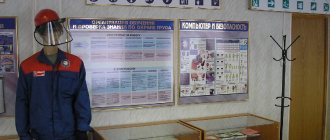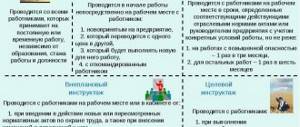Why do we need a labor protection regulation?
The work of enterprises is closely related to labor protection (OH) and safety precautions (HS). Based on the requirements of labor legislation, it is necessary to consolidate the current standards regarding occupational safety and health with administrative documents. The regulatory act should be agreed upon with the trade union body. The document indicates the measures implemented by the administration of the structure to ensure the safety of workers.
The document prescribes the following activities:
- How is work organized in the OT field?
- Legal norms.
- Technical support.
- List of social security for employees.
- How is the rehabilitation program implemented?
- Prevention measures.
- The provision states:
- Responsibilities of management to comply with occupational safety requirements.
- How the person responsible for occupational safety should work, as well as his responsibilities.
- About the procedure for carrying out work by the TB service, including planning.
- How are the rights of employees directly working in production protected?
- Ensuring compliance with standards.
- Compliance with regulations and rules.
- Incurrence of liability for failure to comply or non-compliance with requirements.
- As approved by the composition of the employees in the special assessment commission.
- Formation of an emergency reserve for the implementation of occupational safety measures.
- How employees are trained in the field of occupational safety and health.
- Organization and operation of a service performing security tasks.
All of the above measures can be formed in separate provisions.
The management of the enterprise can additionally indicate what tasks need to be performed and set out their content in the administrative documents of the enterprise.
Responsible person for developing the regulation
In organizational structures, persons responsible for the development of this document are appointed; as a rule, this is the chief engineer of the enterprise. An order is issued and deadlines are set. Participating in the development of the project are:
- Representatives of the OT service.
- Personnel officers.
- Other heads of individual sections and services.
After the draft regulation is formed, it must undergo legal examination. For this purpose, it is transferred to the legal department.
Approval procedure
The document is approved in the following sequence:
- The chief engineer or a person authorized by order issues a project.
- The draft administrative act is considered by the commission at the OT. If there are any comments or suggestions, the latter are included in the content.
- Next, the project is transferred to the lawyer responsible for the development of local acts.
- After an expert assessment and elimination of shortcomings, the project must be agreed upon with the persons who were present at the meeting.
- After approval, it is necessary to approve the local act by the head of the enterprise.
The legislative framework
All local acts relating to occupational safety are developed taking into account the specifics of the activities of each enterprise (Letter of the Ministry of Labor dated June 30, 2016 No. 15-2/OOG-2373).
Since October 28, 2021, the “Model Regulations on OHSMS” (Order No. 438n) has been in effect. This document establishes the basic standards on occupational safety and health standards that employers should follow when developing local regulations regarding occupational safety and health.
When developing regulations on labor protection, it is necessary to take into account the Methodological Recommendations (approved by the Ministry of Labor of the Russian Federation on May 13, 2004).
When developing a list of occupational safety measures, one should be guided by Order of the Ministry of Health and Social Development of the Russian Federation dated March 1, 2012 N 181n.
Structure of a standard provision
To develop a project and publish a document that complies with the standards, it is proposed to adhere to the structure:
- General provisions . A brief content, goals and objectives of developing the document are described, and a list of regulations that must be used in preparation is indicated.
- About responsibilities . What functional responsibilities are assigned to representatives from the enterprise administration and workers in the field of occupational safety, including how the relationship between these two categories is regulated.
- About rights . What rights does each employee have, regardless of status and position?
- How occupational safety activities are financed , including how work clothing, footwear and personal protective equipment are purchased. Ensuring the implementation of measures that require investment. These measures are formed on the basis of comments issued by the special assessment commission and other inspections by enterprise specialists and supervisory authorities.
- Who exactly is responsible for non-compliance with the standards, what to do if a violation is committed.
- The procedure for investigating an emergency situation, including an accident or its prerequisites, is established.
- In the appendices to the regulations, you can specify how first aid is provided, the rules for working with technical devices and equipment involved in the execution of the technological process.
What to pay attention to
It is important that the costs of implementing occupational safety measures can be legally taken into account when calculating income tax (Letter No. 03-03-06/4/95 r) in the amount of no more than 0.2% of production costs. A list of such measures must be developed in accordance with Order No. 181n, which lists more than 30 items, the costs of which will be recognized as a reduction in income tax.
However, it should be taken into account that the list of activities depends on the specifics of the activities of each enterprise (Letter No. 03-03-06/2/12697). At the same time, there are a number of mandatory safety measures for all organizations, for example:
- providing workers with personal protective equipment (Article 221 of the Labor Code of the Russian Federation);
- distribution of milk and therapeutic and preventive nutrition at work with hazardous working conditions (Article 222 of the Labor Code of the Russian Federation);
- sanitary, medical and preventive services for workers (Article 223 of the Labor Code of the Russian Federation);
- education and training in the field of occupational safety (Article 225 of the Labor Code of the Russian Federation).
So, occupational safety measures are a mandatory component of any enterprise. Their correct organization will reduce the costs of organizing labor protection, and reduce taxable profit for the expenses incurred.
Typical list of activities
To reduce the risk of developing occupational diseases and improve working conditions, it is recommended to ensure the implementation of the following measures:
- Conduct a timely special assessment of conditions, enter into agreements with specialized organizations and invite experts to carry out work.
- Gradually improve working conditions based on current standards and comments issued.
- To ensure the safety of workers, automate technological processes, purchase new equipment and programs to perform tasks.
- If a technical device breaks down, then in order to prevent injury, blocking devices should be installed.
- Ensure the protection of equipment involved in technological processes from possible breakdowns and damage, including the worker must be protected from the impact of moving mechanisms.
- Protective equipment should be modernized against negative environmental factors.
- Ensuring that equipment is painted in protective colors so that it can be identified what function it performs.
- To avoid exposure to harmful factors, it is planned to install gas analyzers to monitor excess gas contamination in the air.
- Introduction into production of equipment to provide protection against current.
- Installation of locking devices to protect against open moving mechanisms.
- Design of automated processes to protect workers when handling hazardous substances.
- Protection of workers involved in the storage and transportation of hazardous components.
- Automatic safety device for waste storage.
- Mechanization of work during cleaning of premises, cleaning of ventilation systems, doors and window openings, as well as lanterns.
- Introduction of new technologies while improving mechanical equipment in order to reduce gas pollution, reduce noise levels, vibrations and electromagnetic radiation.
- Improvement of the heating system in work buildings.
- Adjustment work on lighting in accordance with safety standards.
- Arrangement of recreation rooms, including modernization of household premises.
- Installation of drinking water installations in workplaces and cabins.
- Providing employees with special clothing and personal protective equipment.
- Purchase of simulators for first aid training.
- Equipping workers' premises with occupational health and safety stands.
- Organization of training.
- Conducting training in the field of health and safety.
- Purchasing new first aid kits in accordance with regulatory documents.
Who is responsible for worker safety?
Among workers who are superficially familiar with occupational safety requirements, there is an opinion that the occupational safety and health engineer is responsible for their safety. Actually this is not true. Their immediate supervisor is responsible for the safety of specific employees. Managers of enterprises, divisions, departments, etc. are generally responsible for occupational health and safety at work.
Responsibility for compliance with occupational health and safety requirements at the enterprise is also divided into areas of supervision and assigned to employees of appropriate competence. For example, energy service employees appointed by orders are responsible for electrical safety; immediate supervisors are responsible for organizing a system of briefings on labor protection and safety at workplaces and its quality functioning.
The workers themselves are obliged to take care of their own safety. This is a requirement not only of common sense, but also of Art. 214 Labor Code of the Russian Federation. To stay healthy and work, workers need to:
• clearly know and constantly comply with the requirements of safety and labor protection instructions; • complete training and medical examinations on time; • use PPE; • be able to provide first aid; • carefully monitor the environment, analyze production situations and immediately report to the work manager about possible or existing dangers.
During training, medical examination, or work stoppage due to a dangerous situation, the worker retains his average earnings. If he evades responsibility for his own health - does not attend instructions on occupational health and safety, does not undergo medical examinations, regularly violates occupational safety requirements - the employer’s representatives have the right to remove him from work in the appropriate manner. However, no wages are accrued during this time.
Sample regulations on labor protection at an enterprise
A standard document adopted by an enterprise should have the following structure:
- General provisions. It describes the contents of the document briefly, concisely, and on topic. The tasks and goals are described in it, and the regulations on the basis of which the regulations were developed are indicated.
- What responsibilities are assigned to employees and representatives of the enterprise administration, what employees who are part of the occupational safety service must perform, and their rights are also listed.
- Safety measures during work and how they are financed. The section lists measures suggested to ensure a safe environment.
- What are the penalties in case of non-compliance with the requirements of the rules and other regulatory standards. Detailed prosecution of the perpetrators on the basis of legislative acts.
- Algorithms for investigating injuries and other emergency situations.
- The appendices indicate the procedures for providing first aid, what should be included in the first aid kit, and how to work with technological equipment.
What else does the provision include?
The preparation of the document is the responsibility of the safety engineer or chief engineer, but the development is monitored by the facility manager. In this case, it is important that these employees have enough experience in this field. The administration of the enterprise may contact other organizations to prepare the project.
The provision includes all current regulations, and also the following rules are additionally observed:
- You can draw up a document with a group of people at a meeting, and involve a representative from a trade union or labor committee.
- The established TB system must clearly comply with the rules and regulations, as well as procedures for managing the structure.
- It is necessary to take into account the direction of the organization’s activities, including legislative acts and Russian standards.
- The principles of international security of citizens are prescribed.
- Achievements in scientific work are also reflected in the document.
- Indicate when the local act came into effect at the enterprise.
- Familiarization of everyone working in the organization is mandatory.
Preparation of the document must last within the time period specified in the order.
How to approve
For the document to take effect, an order approving the regulations of the labor protection service is required. It must justify the need to put it into effect and indicate from what date it is valid. The same order may contain information:
- on the creation of the SOT itself;
- its manager and employees;
- their official salaries.
It is signed by the head of the organization. Usually he appoints someone responsible for familiarizing staff with the adopted document. After this, in the upper right corner of the PoSOT you can put the stamp “I approve” with the date and signature of the manager.
If a new Regulation on the labor safety service in an organization is introduced, the order must indicate the termination of the old one.
Regulations on the labor protection service at school
Order
Application of labor protection regulations
The labor protection regulations developed at the enterprise are applied for the following purposes:
- When preparing OT instructions.
- If you need to resolve controversial issues between management and employees in the field of TB.
- When regulating the solution to the issue of injury.
- When conducting medical examinations of employees.
- During operation of technological equipment.
- When conducting a special assessment of working conditions.
- First aid.
- Drawing up local acts on occupational safety.
- In other cases.
Everyone working in the organization should be familiar with the documents, so that it does not happen that one of them does not comply with legal norms due to ignorance.
Renewal and revision
In accordance with the Recommendations, the instructions should be reviewed after 5 years. If during this period the working conditions of workers and/or intersectoral and sectoral rules and standard instructions on labor protection have not changed, their validity period may be extended.
The extension is formalized by order. On the first page of the already approved Regulations, the current date, date and signature of the person responsible for the revision are indicated, indicating the position and a description of the signature. The period for which the document is extended is indicated.
Early (before 5 years) changes to instructions are made in the following cases:
- changes in working conditions;
- changes in occupational safety regulations in the relevant industry;
- changes to standard safety instructions;
- introduction of new equipment and technology.
They can also be revised:
- based on the results of the analysis of materials from the investigation of accidents, industrial accidents and occupational diseases;
- at the request of GIT representatives.








